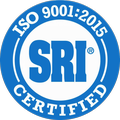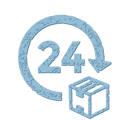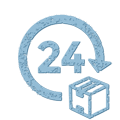Tungsten Heavy Alloy materials are relatively easy to machine and have similar engineering properties to steel. These alloys can be bored, Ch'ak, Perforado, Lu'um, joined, milled, plated, Aserrado, Tu p'uchaj, turned, waterjet cut, both wire and sinker EDM can also be performed. Tungsten Alloys use speeds and feeds similar to Gray Cast Iron. Tungsten Alloy materials becomes easier to machine as the copper content increases. The more tungsten content present the more care must be taken when machining. Carbide tools are suggested for drilling, milling, and turning Tungsten Alloys.
Cutting and Sawing
High-speed abrasive cutoff wheels can be used for cutting. Use a bi-metal blade when sawing, blade pitch to be relative to the thickness of material. Fine blades can be run a high speeds, and courser blades can be run at lower speeds. Coolant is not required, but can be used.
Perforación
Carbide tipped or solid carbide drills are suggested. Increased clearance angles and automatic feeds will help to avoid binding and seizing. Le taladros carburo darán jump'éel ma'alo'ob kuxtal útil ti' le nu'ukula'. Use of coolant or lubricant is highly recommended, chlorinated oil can be used as a coolant. For small holes, pay particular attention to clearance and chip removal to avoid seizing or bit breakage. Drill tap holes to 50-55% of thread hole requirement.
Edm
Both wire and sinker EDM can be used on Tungsten Alloy materials. EDM surfaces can experience hydrogen embrittlement and grain removal.
grinding
Use aluminum oxide or silicon carbide type wheels with a coolant.
molienda
Carbide cutters are suggested. Feed and speeds should follow recommendations for Gray Cast Iron.
Finishing-feeds of 0.003 inch to 0.010 inch per tooth at speeds of 300 Utia'al 700 Sfm
Roughing-feeds of 0.007 inch to 0.015 inch per tooth at speeds of 200 Utia'al 400 Sfm
Tapping
Use high alloy, straight flute or two flute plug spiral point taps. Thread forming taps can be used for small threaded holes. A chlorinated oil coolant may be used.
Turning and Boring
Carbide inserted cutters are suggested. No rake to positive rake for boring, positive rake for turning.
Acabado-0.010 inch to 0.015 inch cutting depth and 0.004 inch to 0.010 inch feet at 250 Utia'al 400 Sfm
Roughing-Cutting depth of 0.030 inch to 0.125 inch and 0.008 inch to 0.015 inch feed at 200 Utia'al 300 Sfm
Acoplamiento
Brazing is a good method of joining Tungsten Alloy material to itself and to other materials. To prevent oxidation, this should be done in a controlled atmosphere. Joint strength is close to that of the parent material. Brazing can alter the chemistry of the material surrounding the joint.
Mechanical Joining by using bolts, pins or standard fasteners is the best option for joining Tungsten Alloy material. Tungsten Alloy can also be threaded to mate to itself.
Shrink Fitting is another good method of joining Tungsten Alloy material to steel.
Silver Soldering is an efficient and practical method of joining Tungsten Alloys to itself or steel.
Please feel free to contact us for Tungsten heavy alloys and sizes available for Wéet O envío k'iin uláak' Bey u kajtalo'ob ichil personalizadas.






